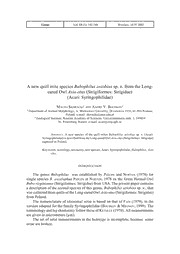
A new quill mite species Bubophilus asiobius sp. n. from the Long-eared Owl Asio otus (Strigiformes: Strigidae) (Acari: Syringophilidae) PDF
Preview A new quill mite species Bubophilus asiobius sp. n. from the Long-eared Owl Asio otus (Strigiformes: Strigidae) (Acari: Syringophilidae)
Genus Vol. 13 (1): 141-144 Wroc³aw, 10 IV 2002 A new quill mite species Bubophilus asiobius sp. n. from the Long- eared Owl Asio otus (Strigiformes: Strigidae) (Acari: Syringophilidae) MACIEJ SKORACKI1 AND ANDRE V. BOCHKOV2 1 Department of Animal Morphology, A. Mickiewicz Univerity, 28 czerwca 1956; 61-484 Poznan; Poland; e-mail: [email protected] 2 Zoological Institute, Russian Academy of Sciences, Universitetskaya emb. 1, 199034 St. Petersburg, Russia; e-mail: [email protected] ABSTRACT. A new species of the quill mites Bubophilus asiobius sp. n. (Acari: Syringophilidae) is described from the Long-eared Owl Asio otus (Strigiformes: Strigidae) captured in Poland. Key words: acarology, taxonomy, new species, Acari, Syringophilidae, Bubophilus, Asio otus. INTRODUCTION The genus Bubophilus was established by PHILIPS and NORTON (1978) for single species B. ascalaphus PHILIPS et NORTON, 1978 ex the Great Horned Owl Bubo virginianus (Strigiformes: Strigidae) from USA. The present paper contains a description of the second species of this genus, Bubophilus asiobius sp. n., that was collected from quills of the Long-eared Owl Asio otus (Strigiformes: Strigidae) from Poland. The nomenclature of idiosomal setae is based on that of FAIN (1979), in the version adapted for the family Syringophilidae (BOCHKOV & MRONOV, 1999). The terminology and leg chaetotaxy follow these of KETHLEY (1970). All measurements are given in micrometers (µm). The set of setal measurements in the holotype is incomplete, because some setae are broken. 142 MACIEJ SKORACKI, ANDRE V. BOCHKOV The holotype and most of the paratypes are deposited at the Department of Animal Morphology of A. Mickiewicz University, Poznañ, Poland, other paratypes – at the Zoological Institute of the Russian Academy of Sciences, Sankt-Petersburg, Russia. Bubophilus asiobius n. sp. ETYMOLOGY Combination of Asio, the generic name of the host, and bios (Gr., life). 1, 2. Bubophilus asiobius sp. n., female: 1 - dorsal view, 2 - ventral view A NEW QUILL MITE SPECIES BUBOPHILUS ASIOBIUS SP. N. 143 DESCRIPTION Female (Figs. 1-7). Total length of holotype 715 (695-770 in 11 paratypes), width at level of setae h 180 (170-200). Gnathosoma: Hypostomal apex smooth, hypostomal lips tongue-like (Fig. 3, 4). Stylophore 190 (180-185) in length, slightly tapering posteriorly, not extending beyond the propodosomal plate. Peritremes: lateral branch with 1-2 chambers, longitudinal branch with 4-6 cham- bers (Fig. 5). Dorsal idiosoma: Cuticular striations as in Fig. 1. Propodosomal plate weakly sclerotized, with deep cleft on anterior margin. Seate vi, ve, sci, sce and d1 situated on propodosomal plate. Hysterosomal plate absent. Pygidial plate well developed, with indistinct anterior margin. Distances l1-d2 and l2-d2 subequal or setae slightly closer to l1 than to l2. Length of setae: vi 27 (25-30); ve 50 (40-55); sci: 57 (50-70); sce (225-260); h 196 (200-255); d1 (250-275); d2 (145-170); d4 30 (35- 40); d5 52 (40-45); l1 (175-185); l2 152 (140-170); l4 166 (160-205); l5 420 (435- 485). Anal setae a1 and a2 subequall 27 (25-30). 3-7. Bubophilus asiobius sp. n., female: 3 - gnathosoma, dorsal view, 4 - gnathosoma, ventral view, 5 – peritremes, 6 - setae a’IV, 7 - solenidia: a - ω on tarsus I. , b - ϕ on tibia I, c - σ on genu I 144 MACIEJ SKORACKI, ANDRE V. BOCHKOV Ventral idiosoma: Cuticular striations as in Fig. 2. Length of setae: ic1 (135- 165); ic3 (105-120), pg1 168 (175-195); pg2 71 (70-85); pg3 (195-220), g1 45 (40-45); g2 40 (40-50). Legs. Epimeres I slightly divergent, fused to epimeres II. Coxae III and IV weakly sclerotized. Setae tc’III and IV each about ½ length of tc’’III and IV. Setae a’ and a’’ III-IV with 8-12 tines (Fig. 6). Solenidia as in Fig. 7. Length of setae: 1b 63 (60-70); 2b 157 (145-160); 3b 45 (40-45); sc1 27 (25-30); sc2 (45-50); sc3 54 (55-65); sc4 (45-60). Male. Unknown. DIAGNOSIS The female of new species differs from B. ascalaphus in the following characters: in B. asiobius sp. n. the body length is 695-770, the length of setae vi, ve and sci are 25-30, 40-55 and 50-70 respectively; in B. ascalaphus the body length is 560-645, the lengths of setae vi, ve and sci are 40-53, 70-110 and 110-190 respectively. TYPE MATERIAL Holotype female (coll. No. S 6.1), paratypes 15 females, 7 nymphae and 6 larvae ex Asio otus (tail feathers). 6 km NW from Dar³ówko Wschodnie; Poland; 30th October 1999; M. SKORACKI & W. BUSSE coll. ACKNOWLEDGEMENTS We thank Dr. S. MIRONOV (Zoological Institute, St. Petersburg, Russia) for critically revieving of the manuscript. REFERENCES BOCHKOV, A. V., MIRONOV, S. V. 1999. New quill mite species of the family Syringophilidae (Acari: Cheyletoidea) from the European part of Russia. Acarina, 7 (1): 35-45. FAIN, A. 1979. Idiosomal and leg chaetotaxy in the Cheyletidae. Int. J. Acarol., 5 (4): 305-310. KETHLEY, J. B. 1970. A revision of the family Syringophilidae (Prostigmata: Acarina). Contrib. Amer. Entomol. Inst., 5 (6): 1-76. PHILIPS, J. R., NORTON, R. A. 1978. Bubophilus ascalaphus gen. et sp. n. (Acarina: Syringophilidae) from the Quills of a Greate Horned Owl (Bubo virginianus). J. Parasitol., 64 (5): 900-904.
